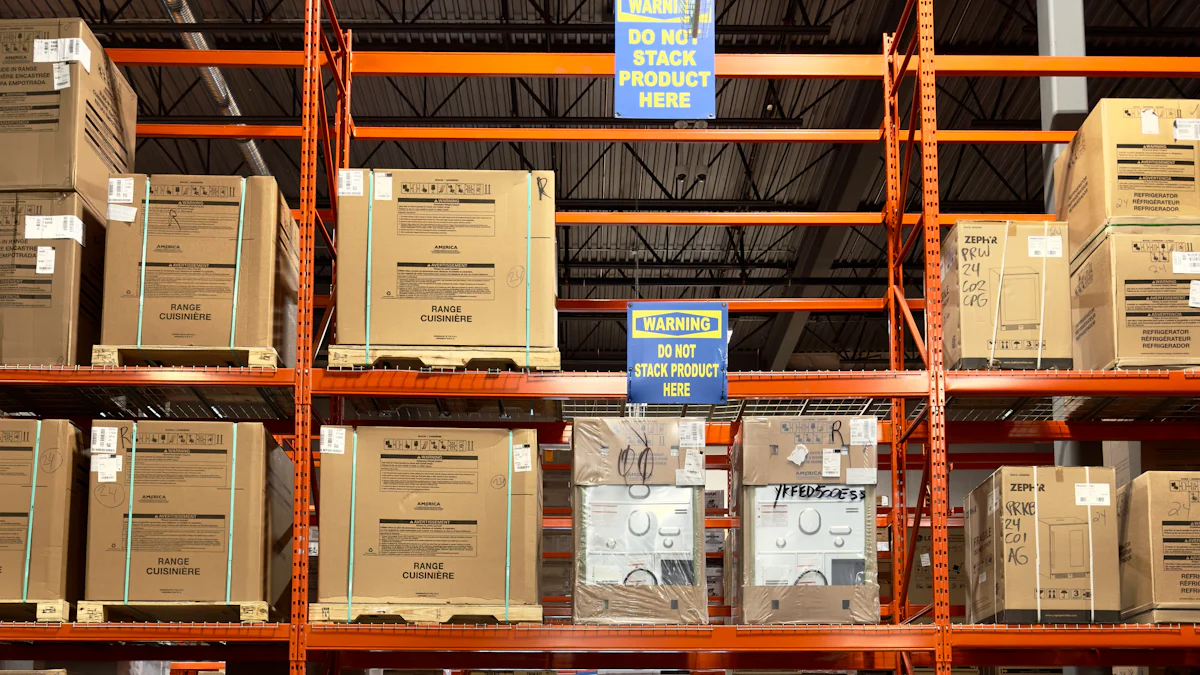5 Practical Tips to Optimize Supply Chain Costs

Cost efficiency plays a pivotal role in building a resilient and effective supply chain. Businesses often face challenges such as rising operational costs, labor shortages, and unpredictable market demands. These issues, coupled with global complexities, can lead to shipping delays and inflated expenses. Supply chain costs, which can range from 5% to 50% of a product's total cost, highlight the need for strategic interventions. Addressing these challenges through end-to-end supply chain optimization ensures better visibility, adaptability, and cost control, enabling businesses to thrive in competitive markets.
Optimize Inventory Management for Supply Chain Efficiency

Implement Just-in-Time (JIT) Inventory Practices
Minimize holding costs by reducing excess stock.
Just-in-Time (JIT) inventory practices focus on maintaining minimal stock levels to reduce holding costs. By aligning inventory with production schedules, businesses can avoid the expenses associated with excess stock, such as storage fees and obsolescence. This approach ensures that resources are allocated efficiently, contributing to overall cost savings. However, JIT requires precise coordination with suppliers to ensure timely deliveries. Any disruption in the supply chain can lead to production delays or missed sales opportunities.
Align inventory levels with real-time demand for better flow.
JIT inventory management enhances operational efficiency by synchronizing inventory levels with real-time demand. This method reduces waste and ensures that products are available when needed, improving customer satisfaction. Businesses leveraging JIT can respond more effectively to market changes, maintaining a competitive edge. However, this approach demands robust collaboration across the supply chain to mitigate risks such as supplier dependency or sudden demand spikes.
Tip: Combining JIT practices with advanced forecasting tools can help businesses balance minimal inventory levels with demand fluctuations, reducing risks while maximizing efficiency.
Leverage AI-Driven Demand Forecasting with JusLink
Use historical data and AI tools to predict demand accurately.
AI-driven demand forecasting, such as that offered by JusLink, utilizes historical data to predict future inventory needs with remarkable accuracy. By analyzing trends and patterns, businesses can align their inventory management strategies with anticipated demand. This reduces the likelihood of overstocking or understocking, ensuring that resources are used effectively. AI tools also automate data collection and analysis, minimizing human error and freeing up resources for strategic decision-making.
Avoid overstocking or understocking with intelligent replenishment.
JusLink’s intelligent replenishment system dynamically adjusts inventory levels based on real-time insights. This capability ensures that businesses maintain optimal stock levels, avoiding the costs associated with excess inventory or stockouts. AI-driven systems also provide early warnings of potential risks, enabling proactive measures to address supply chain disruptions. Industries that have adopted AI forecasting report significant cost savings and improved operational efficiency, demonstrating the transformative potential of these technologies.
Note: AI tools like JusLink not only enhance inventory management but also support scalability, making them ideal for businesses experiencing growth.
Streamline Transportation and Logistics for Cost Optimization

Consolidate Shipments and Optimize Routes
Combine smaller shipments to reduce transportation expenses.
Consolidating shipments is a proven strategy to reduce transportation costs. Businesses can group smaller shipments based on proximity, supplier, or mode of transport to maximize cargo space utilization and minimize transit distances. For example, geographic consolidation groups shipments by location, reducing travel distances and fuel consumption. Vendor consolidation combines orders from the same supplier, simplifying procurement and enhancing negotiation power. These methods not only lower transportation expenses but also streamline supply chain logistics optimisation.
Strategy | Description | Cost Savings Benefits |
|---|---|---|
Geographic Consolidation | Grouping shipments based on proximity to minimize transportation distances. | Reduced transit distances and efficient routing lead to lower transportation costs. |
Vendor Consolidation | Combining shipments from the same supplier to streamline procurement. | Simplifies receiving processes and enhances negotiation power for bulk discounts. |
Mode of Transportation Consolidation | Combining shipments using the same transport mode for efficiency. | Maximizes cargo space utilization, reducing handling costs and transportation expenses. |
Container or Pallet Consolidation | Optimizing space within containers or pallets to minimize waste. | Reduces the number of shipments needed, leading to lower transportation costs. |
Use route optimization tools to enhance supply chain efficiency.
Route optimization tools play a critical role in achieving peak efficiency in logistics. These tools identify the best routes by analyzing factors such as traffic, delivery schedules, and fuel consumption. Optimized vehicle routing minimizes travel distances, reducing fuel costs and delivery times. AI-driven planning further enhances driver and vehicle utilization, cutting maintenance expenses and improving operational efficiency. Businesses that adopt these tools experience significant cost savings and improved delivery performance, ensuring their supply chain logistics operate at peak efficiency.
Tip: Leveraging technology-driven consolidation alongside route optimization tools can maximize cost savings and operational efficiency.
Partner with Reliable 3PL Providers for End-to-End Supply Chain Support
Outsource logistics to reduce operational overhead.
Third-party logistics (3PL) providers offer specialized expertise in managing supply chain operations. By outsourcing logistics, businesses can reduce overhead costs, avoid infrastructure investments, and focus on core activities. 3PL providers bring economies of scale, enabling cost savings through bulk transportation discounts and efficient resource allocation. Their flexibility allows businesses to adapt to changing market demands without compromising service quality.
Choose providers with proven cost-saving strategies.
Selecting the right 3PL provider is crucial for cost optimization. Businesses should evaluate providers based on reliability, customer service, technology, and transparent pricing. Providers with robust networks and scalable solutions ensure seamless operations during peak demand periods. Additionally, their expertise in international compliance and logistics management enhances efficiency, reducing delays and associated costs. Partnering with a reliable 3PL provider not only improves customer satisfaction but also ensures long-term cost efficiency.
Note: Collaborating with 3PL providers that utilize advanced technologies can further enhance supply chain logistics optimisation and scalability.
Leverage Technology and Automation in Supply Chain Optimization
Use JusLink for End-to-End Supply Chain Visibility
Gain real-time insights into supply chain operations.
End-to-end visibility tools like JusLink empower businesses with real-time insights into their supply chain operations. These tools provide a comprehensive view of inventory, transportation, and supplier performance, enabling businesses to make informed decisions. By accessing precise data and knowledge, companies can mitigate disruptions, improve agility, and enhance productivity. For example, businesses using visibility tools have reported saving $300K-$500K monthly on fines and penalties while reducing detention costs by $10 million annually.
Real-time insights also help businesses adapt to market changes swiftly. Enhanced visibility ensures better inventory control and customer satisfaction. Companies can identify supply and demand gaps, improving their planning and response times. This capability strengthens operational efficiency and positions businesses to remain competitive in dynamic markets.
Identify inefficiencies and implement cost-saving measures.
Supply chain visibility tools uncover inefficiencies such as data fragmentation, outdated technology, and poor collaboration with suppliers. JusLink addresses these challenges by integrating data across systems and providing actionable insights. Businesses can identify bottlenecks, track goods in real-time, and improve data accuracy.
For instance, outdated technology often hampers operational efficiency. JusLink’s advanced features streamline processes, ensuring seamless integration and reducing tracking errors. By addressing inefficiencies, businesses can implement cost-saving measures that enhance overall supply chain optimisation.
Automate Repetitive Processes for Enhanced Efficiency
Reduce manual errors and labor costs with automation.
Automation technologies like robotic process automation (RPA) and IoT devices minimize human intervention in repetitive tasks. These tools reduce manual errors, lower labor costs, and enhance operational efficiency. For example, AI-driven automation eliminates bottlenecks and ensures regulatory compliance, streamlining the management of goods and services.
Automation also facilitates faster production and delivery speeds. Businesses adopting these technologies experience improved customer satisfaction, particularly in last-mile delivery. By automating routine tasks, companies can allocate resources to strategic planning and innovation, driving long-term growth.
Improve process speed and accuracy through digital tools.
Digital tools powered by AI and machine learning enhance process speed and accuracy. JusLink’s automated application management tracks shipment statuses and detects anomalies, ensuring timely deliveries. These tools optimize inventory management and reduce waste, contributing to cost savings.
Automation also improves decision-making by providing real-time data and predictive analytics. Businesses can streamline their planning processes, adapt to disruptions, and maintain quality standards. By leveraging automation, companies achieve greater efficiency and scalability, ensuring their supply chains remain resilient in competitive markets.
Tip: Combining automation with advanced planning tools ensures seamless operations and maximizes cost-saving potential.
Build Strong Supplier Relationships to Enhance Efficiency
Negotiate Favorable Terms with Suppliers
Secure volume discounts and flexible payment options.
Strong supplier relationships enable businesses to negotiate supplier costs effectively, leading to significant savings. Supply chain managers can secure volume discounts by bundling orders or committing to long-term contracts. Flexible payment options, such as extended payment terms, improve cash flow and reduce financial strain. These strategies enhance profitability while fostering collaboration. For instance, suppliers often prioritize businesses with consistent orders, offering better terms and faster deliveries.
To achieve favorable terms, supply chain managers should adopt a structured negotiation strategy. Preparing thoroughly by researching market rates and vendor competition ensures informed discussions. Timing negotiations around vendor fiscal cycles can also yield better deals. Documenting all agreements in writing minimizes misunderstandings and strengthens partnerships.
Tip: Building mutual trust and respect with suppliers creates opportunities for shared cost-saving initiatives, such as joint investments in technology or process improvements.
Collaborate on shared cost-saving initiatives.
Collaboration with suppliers on cost-saving initiatives benefits both parties. Joint efforts, such as streamlining production schedules or optimizing transportation routes, reduce costs across the end-to-end supply chain. For example, suppliers and businesses can co-develop packaging solutions that minimize waste and lower shipping expenses. These initiatives not only cut costs but also improve operational efficiency and strengthen long-term partnerships.
Diversify Supplier Base for Risk Mitigation
Reduce dependency on single suppliers to improve resilience.
Relying on a single supplier exposes businesses to significant risks, including operational disruptions caused by natural disasters, labor strikes, or geopolitical instability. Diversifying the supplier base mitigates these risks by spreading dependencies across multiple suppliers and locations. For example, a coffee company sourcing beans from various farmers and countries ensures a steady supply despite regional challenges.
Supplier diversification also enhances resilience by enabling supply chain managers to maintain operations during unforeseen disruptions. Developing contingency plans and alternative sourcing strategies ensures business continuity, even when one supplier faces challenges.
Leverage competition to achieve better pricing and terms.
Engaging multiple suppliers fosters competition, driving better pricing and terms. Supply chain managers can request quotes from several vendors to identify the most cost-effective options. This strategy not only reduces costs but also encourages suppliers to offer value-added services, such as faster delivery or improved quality. However, managing a diversified supplier base requires investment in technologies and systems to ensure seamless integration and communication.
Note: While diversification involves higher upfront costs, the long-term benefits of improved resilience and cost savings outweigh the initial investment.
Optimizing supply chain costs requires a strategic approach. The five practical tips outlined in this blog provide a roadmap for achieving supply chain efficiency and resilience:
Analyze your supply chain to identify inefficiencies and cost drivers.
Set clear optimization goals with measurable targets.
Leverage advanced tools like JusLink for demand forecasting and end-to-end supply chain optimization.
Consolidate shipments and optimize routes to reduce transportation expenses.
Build strong supplier relationships to secure better terms and mitigate risks.
Consolidating less-than-truckload shipments into full truckloads and using sailing schedules to optimize loads can significantly reduce shipping costs.
Businesses can take immediate steps to improve supply chain resilience by deploying robust inventory management solutions, planning capacity effectively, and implementing sound sales and operations planning processes. Leveraging technology like JusLink enhances visibility and customer demand planning, while fostering supplier collaboration strengthens the overall supply chain strategy.
By acting now, businesses can adapt to market changes, meet demand efficiently, and secure long-term success in a competitive landscape.
See Also
Discover 5 Creative Strategies For Supply Chain Optimization
Understanding The Financial Aspects Of Supply Chain Efficiency
Key Strategies To Ensure Cybersecurity In Supply Chains
Proven Techniques For Achieving Supply Chain Optimization Success
